|
Welcome to Clean Air Quarterly, a newsletter from the Ports of Seattle, Tacoma, and the Northwest Seaport Alliance sharing clean air and climate efforts in our regional gateway. Each issue of the newsletter showcases projects and milestones across our gateway, features a partner who is making a difference in our region, and highlights upcoming opportunities for engaging with us including events, commission meetings, webinars, and events!
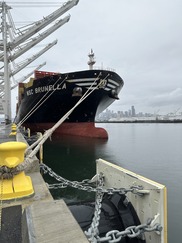
On April 10, 2023, the container ship MSC Brunella plugged in to shore power at Terminal 5 in Seattle, marking the first shore power connection at the terminal and the first international container ship to plug in within our gateway.
When a vessel is at dock, power is needed to run essential onboard functions, such as cooling refrigerated containers and powering lights and computer systems. Shore power allows a vessel to shut down its engines and plug in to the electrical grid rather than burning fuel.
This infrastructure installation is part of the Terminal 5 Modernization Program. In addition, there are NWSA efforts underway to make shore power available at our other international container terminals by the end of the decade. Learn more here.
|

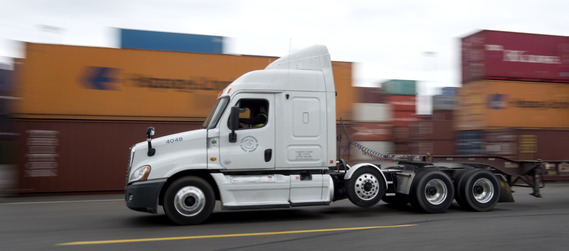 Puget Sound Zero Emission Truck Collaborative ('the Collaborative') is Washington’s first multi-stakeholder group uniting to accelerate the transition to zero emission trucks and infrastructure in Western Washington. The Collaborative convened for its first meeting on June 30, 2023, bringing together representatives with varying perspectives such as truck manufacturers, trucking companies, near-port community groups, NGOs, retailers, warehousing companies, utilities, state and local government agencies, and our Puget Sound ports. Together, this diverse group of stakeholders will develop a 30-year strategy for transitioning to zero-emission drayage trucking in the Seattle-Tacoma gateway by 2050 or sooner. Supported by Washington State Department of Transportation grant funding, NWSA hired an independent consulting team to serve as official facilitator and coordinator of the Collaborative. This team is led by Ross Strategic and includes GNA, Cascadia Law Group, and Stepherson & Associates.
For more information on the PS-ZETC, please contact Tom Beierle at Ross Strategic at tbeierle@rossstrategic.com.
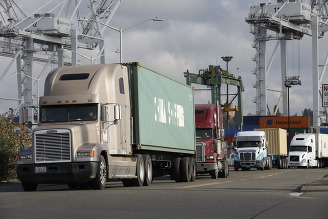
While the Puget Sound Zero Emission Truck Collaborative engages in it's planning efforts, the NWSA is undertaking near term actions to help accelerate these goals. This includes an upcoming ZE truck demonstration program.
As NWSA develops a demonstration program for zero emission drayage trucks in our gateway using federal and state grant funds in the coming years, we published a Request For Information (RFI) in April 2023 to gather input on the design of a future incentive program. The RFI was open for 6 weeks and received 33 responses. Staff are reviewing the responses and will use the information to structure an incentive program for zero emission trucks and charging/fueling infrastructure.
The RFI was available here – we are still accepting input to the design of a future program online.
|

Wallenius Wilhelmsen Solutions (WWS) has made a voluntary investment to operate four all-electric shuttle vans at their facility in Tacoma. WWS is a major auto terminal in the South harbor and ships vehicles and cars into the region from markets in East Asia. Consumers on the West Coast who purchase a Hyundai, Nissan, Volvo, or GM vehicle are getting a vehicle that was imported through their terminal!
The movement of autos has several components, one of them is the need to shuttle the vehicles to and from the terminal and to different locations on the terminal. These vans used to shuttle the vehicles often go 60 miles a day with a lot of idling. Switching these to all electric is a significant investment by WWS and an important step to reducing seaport related operational emissions. The vast majority of emissions related to maritime activity are not owned or controlled by NWPCAS signatories, but we are still committed to their elimination by 2050 or sooner. These pro-active investments by our maritime and industry partners are key to achieving our gateway’s zero emission goals.
|
 |
Earlier this year, Port of Seattle reached an agreement with Puget Sound Energy (PSE) to purchase more than 240,000 therms of renewable natural gas each year. Purchasing RNG allows the Port to cut carbon emissions at cruise terminals and the maritime maintenance facility by about half. This investment will result in a reduction of carbon emissions of about 1,291 metric tons each year they participate in the program, helping the Port to achieve its emissions reduction goals while implementing longer term solutions to phase out fossil fuels. The agreement is part of PSE’s voluntary Renewable Natural Gas program. Read more here.
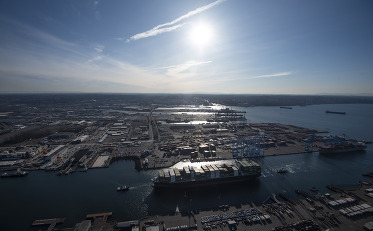
On July 18, the Port of Tacoma Commission adopted new greenhouse gas reduction targets for scope 1 and 2 emissions, accelerating ambition to achieve net zero by 2040, from 2050. Scope 1 and 2 emissions include direct emissions from port owned and operated buildings and vehicles and indirect emissions from electricity purchased for these facilities. In order to meet this target, the port will accelerate its work to install electric vehicle charging, purchase zero emission vehicles and equipment, electrify buildings, and purchase renewable fuels to displace existing fossil fuels. One such investment is the Port of Tacoma Administration Building EV Charging station project, which is expected to break ground this year.
In parallel with the port’s efforts to reduce scope 1 and 2 emissions, the Port of Tacoma continues to work with partners as part of the Northwest Ports Clean Air Strategy, which includes the Northwest Seaport Alliance, the Port of Seattle, and the Port of Vancouver, to reduce its scope 3 emissions. Scope 3 emissions include all other seaport associated emissions that are not directly controlled by the port, such as cargo ships, drayage trucks, and facilities leased to private companies. Examples of actions the port is taking to address scope 3 emissions, in partnership with the Northwest Seaport Alliance, are the Husky Terminal Shore Power project, the South Intermodal Yard Electric Terminal Tractor project, and our work with regional partners to establish the Puget Sound Zero Emission Truck Collaborative.
Read more here.
|
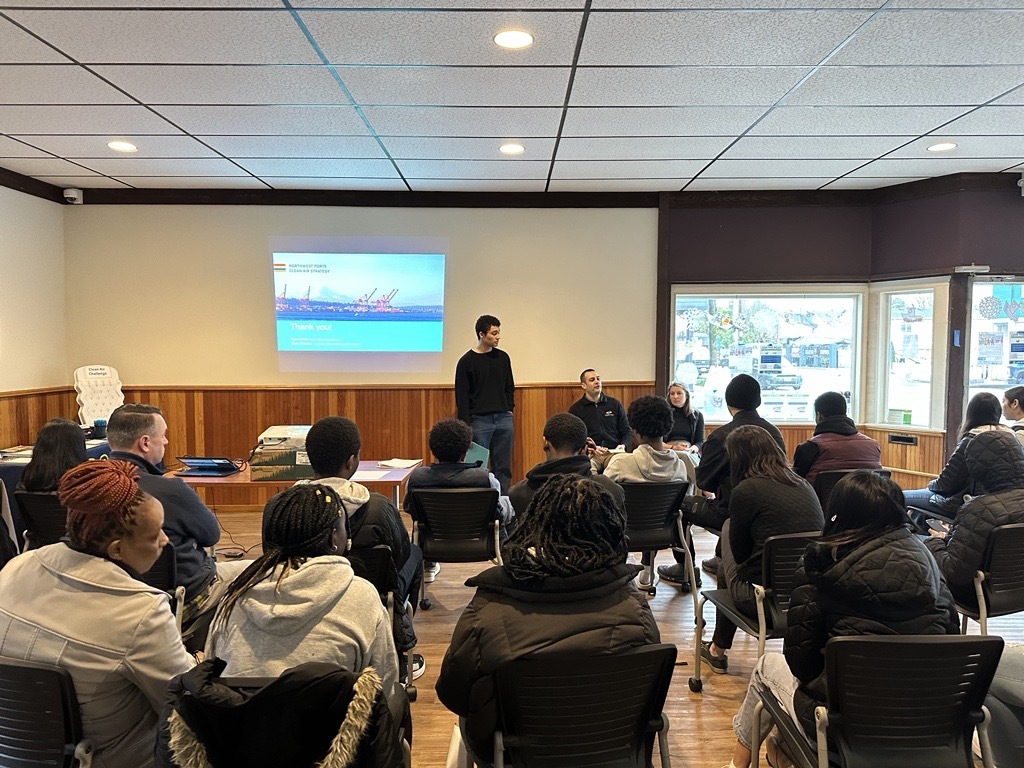
Port of Seattle and NWSA kicked off the event season by co-leading a panel with youth leaders from the Duwamish Valley to engage local communities in talking about climate change action and pursuing meaningful solutions. With a turn-out of over 100 participants, youth shared their experiences of climate change affecting their day-to-day lives and left inspiring messages encouraging others to get involved at any level they can, from picking up trash to volunteering with larger organizations like Duwamish Valley Sustainability Association.

Seattle City Light is the publicly owned electric utility serving the greater Seattle area. It was the first electric utility in the country to be certified as carbon neutral in 2005.
We talked with John LeCompt, a Strategic Electrification Engineer in the Electrification & Strategic Technology Division, a new division formed in 2019. The division is developing and implementing programs and incentives to accelerate electrification of both transport and built infrastructure, while updating and preparing the City’s electrical grid for this transition.
Also starting in 2019, the utility worked with the NWSA and Port of Seattle to develop a decarbonization strategy, which resulted in the Seattle Waterfront Clean Energy Strategy (SWCES).
Tell us more about the project. How did it come about? What was the process in developing the strategy?
The Northwest Seaport Alliance and Port of Seattle are both part of the Northwest Clean Air Strategy, which has a goal of zero emissions by 2050. Currently, electricity is only 22% of all the energy used for maritime operations, meaning the remaining 78% will largely need to be shifted to the electrical grid. This led to our agencies understanding that we need a robust strategy to support that transition to electrification, and to prepare both the grid and associated infrastructure.
So we hired a consultant and began a stakeholder process that included key Port tenants, nearby industries, communities, and research organizations among other to start to understand the need, which then led to the development of the SWCES.
By developing a strategy together for replacing fossil fuels and implementing zero-emission solutions we’ll ensure there’s adequate power capacity and minimal time lost from miscommunication and misalignment.
What are some of key components of the SWCES?
A big one is adaptability. Developing a strategy is considerably different from developing a plan. Predicting future energy loads is difficult, with many uncertainties related to market dynamics, legislative pressure to decarbonize, funding opportunities and motivation levels to adopt electrification. There is also significant uncertainty around technological development and commercial advancements (e.g., lithium-ion battery packs have dropped ~90% since 2010). Recognizing this high degree of uncertainty, it is crucial for us to:
-
Develop solutions that leave options open to future advancements, and
-
Revisit and refine the strategy and resulting plans on a regular basis.
Utilities are transitioning to becoming energy providers, and this is new territory for us. We need partners to learn from and help us grow, and the SWCES provides us a framework in which to do that.
Do you have any advice or lessons learned from the project so far?
We need all perspectives at the table to build our energy transition. How we all produce, manage and use energy is changing in historic ways right now. Our utility is transitioning from being a one-dimensional electricity provider with very effective energy efficiency programs to being a broader provider of energy and transportation with continued efficiency programs, plus energy storage and management being thrown in as well. Energy users are enacting climate change commitments to find and use equipment and processes that are new to them. One of the challenges is that the electricity resource and the distribution grid itself are limited resources and couldn’t support the full new load without some wise planning. The SWCES team is comparing the benefits of both traditional and non-traditional solutions for meeting those forecasted loads to create a set of recommendations to discuss with stakeholders. By working together on solutions we stand the best chance to meet our mutual needs.
|
|